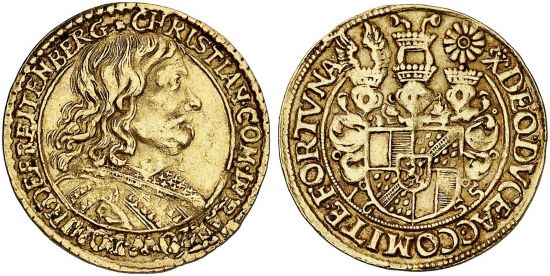Rantzau 1655 ducat Fr-2449
This specimen was lot 3733 in Künker sale 294 (Osnabrück, Germany, July 2017), where it sold for €7,000 (about US$9,435 including buyer's fees). The catalog description[1] noted,
"RANTZAU, GRAFSCHAFT, Christian, 1650-1663. Dukat 1655, Rantzau. Brustbild r.//Dreifach behelmtes, vierfeldiges Wappen mit Mittelschild, unten zu den Seiten die geteilte Jahreszahl 16 - 55. GOLD. Von großer Seltenheit. Attraktives Exemplar, sehr schön. (Germany, county of Rantzau, Christian, 1650-63, ducat of 1655, Rantzau mint. Obverse: bust right; reverse: triple helmeted, quartered arms with escutcheon, date below. Very rare, attractive example, very fine.)
Nach dem Aussterben der Linie Pinneberg des Hauses Schaumburg wurde die Grafschaft Pinneberg im Jahr 1640 zwischen Dänemark und Holstein-Gottorp aufgeteilt. Herzog Friedrich III. von Holstein-Gottorp verkaufte 1649 die an ihn gefallenen Kirchspiele Barmstedt und Elmshorn an Christian von Rantzau, den Münzherrn des hier angebotenen, äußerst seltenen Dukaten. Im Jahr 1650 erreichte Christian die Erhebung seiner Länder zur Grafschaft und die Aufnahme in den Reichsgrafenstand. Im Jahr 1655 erhielt Graf Christian die Mitgliedschaft als Stand des niedersächsischen Reichskreises mit Sitz und Stimme wie die anderen Kreisstände. Dies war auch die Vorbedingung für die Ausübung des ihm von Kaiser Ferdinand III. zugestandenen Münzrechtes. Bereits am 28. Februar 1655 schloß der Graf in Hamburg mit dem dortigen städtischen Münzmeister Matthias Freude einen Vertrag, demzufolge Freude in Hamburg die Stempel und Zaine vorbereiten und dann nach Schloß Rantzau zur Prägung von Dukaten und Talern transportieren sollte. (After the extinction of the Pinneberg line of the house of Schaumburg, the county of Pinneberg was divided in 1640 between Denmark and Holstein-Gottorp. Duke Friedrich III of Holstein-Gottorp sold in 1649 Barmstedt and Elmshorn to Christian von Rantzau, the mintmaster of the thaler offered here. In the year 1650 Christian was promoted to count of the empire. In 1655 Count Christian was admitted to the diet of the circle of Lower Saxony empire. This was also the precondition for the exercise of the mint-right conferred on him by Emperor Ferdinand III. On the 28th of February, 1655, the Count of Hamburg concluded a contract with Hamburg's local treasurer, Matthias Freude, in order to prepare the dies in Hamburg, and to transport them to Rantzau Castle to strike ducats and thalers.)"
This type, struck 1655-58, is the only ducat of this ruler.
Recorded mintage: unknown.
Specification: 3.5 g, 0.986 fine gold, this specimen 3,46 g.
Catalog reference: KM 1, Fr-2449; Lange 1005; Meyer 1.
- Craig, William D., Germanic Coinages: Charlemagne through Wilhelm II, Mountain View, CA: 1954.
- Friedberg, Arthur L. and Ira S. Friedberg, Gold Coins of the World, From Ancient Times to the Present, 9th ed., Clifton, NJ: Coin and Currency Institute, 2017.
- Cuhaj, George S., and Thomas Michael, Standard Catalog of World Coins, 1601-1700, 6th ed., Iola, WI: Krause Publications, 2014.
- [1]Künker Münzauktionen und Goldhandel, Katalog 294: Goldprägungen | Deutsche Münzen ab 1871 | Russische Münzen und Medaillen, Osnabrück: Fritz Rudolf Künker GmbH & Co., AG, 2017.
Links to:

